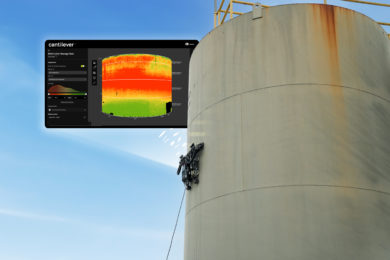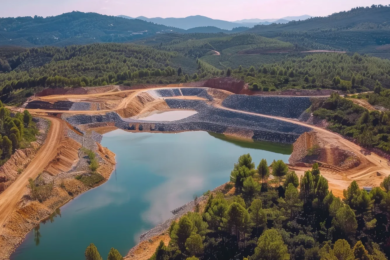As International Mining finishes its August article on the world copper situation and new technologies and ideas for its recovery, Ronald Thiessen, President and CEO of Northern Dynasty has some interesting comments on copper. Since acquiring the Pebble project in 2001, Northern Dynasty has delineated and advanced one of the world’s greatest stores of mineral wealth. Located in southwest Alaska, the deposit is remarkable for both its size and composition. Current resource estimate includes 5,940 Mt in the Measured and Indicated category containing 55,000 Mlb copper, 66.9 Moz gold and 3,300 Mlb molybdenum; and 4,840 Mt in the Inferred category, containing 25,600 Mlb copper, 40.4 Moz gold and 2,300 Mlb molybdenum. Quantities of silver, palladium and rhenium also occur in the deposit.
In 2007, a wholly-owned affiliate of Northern Dynasty entered a 50:50 partnership with a wholly-owned subsidiary of Anglo American plc to permit, construct and operate a modern, long-life mine at Pebble. Based on Anglo American’s staged investment of $1.425 to $1.5 billion, both companies share equal ownership, board representation and rights in the Alaska-based Pebble Limited Partnership.
Thiessen notes: “Information technology has advanced significantly since the first general purpose computers arrived on the scene. Comparable in size to a studio apartment, they were a far cry from the portable, pocket size internet-enabled devices of today; for my generation who can forget those punch cards and Fortran! But while technology may be perpetually shrinking in size, the amount of energy required to fuel, drive, energize or operate the many conveniences of our lifestyles has grown substantially over the past 50 years. Information technology is more accessible than ever before. The list of support devices or entertainment gadgets for modern lifestyles is rapidly expanding – but few pause to consider their energy requirements.
“In the US, a full 22% of total energy consumption is used for residential purposes, and the average household consumes more than 48,000 W of energy. This encompasses some mundane items with surprising power requirements, such as the 1,500-plus W used by hairdryers, coffee machines and microwaves; the 339 W used by plasma screen televisions; and the 5,000 W used by air conditioners. Smaller items also factor – the average iPhone uses 5 W, computers between 22 and 250 W, and a Sony Playstation 3 can use 130 W. In fact, leaving a Playstation 3 on for an entire day can create 1.65 kg in CO2 emissions. Wireless internet routers may only use 10 W, but can emit 48 kg of CO2 over a year.
“The US is the largest energy consumer in the world, using 25% of total world energy supply for just 5% of the world’s population. Canada also has some of the highest per capita usage rates. But governments and organisations are setting efficiency goals and seeking to expand renewable energy contributions to world supply beyond the current 7%. Geothermal energy has the potential to become a large scale provider and is now used in more than 70 countries. Solar and wind power generation capacity have also increased substantially. In theory, capturing extremely small proportions of solar and wind energy on the planet’s surface could help meet worldwide energy needs, however these need judicious analysis in terms of efficiency, cost and a true measure of offsetting consequences.
“And of course copper plays a vital role as the world strives to both meet energy usage reduction quotas and expand renewable generation methods. For example, it is an essential ingredient for gathering wind and solar power. A 1 MW photovoltaic solar power installation requires 4 t of copper, as does a 1 MW wind turbine. Copper is also an important part of direct-exchange geothermal heating and cooling systems. From an energy-efficiency standpoint, copper is a superior thermal conductor of electricity which means the more copper contained in electrical wiring and cabling, the less energy is lost as heat. Copper wires result in lower electrical transmission losses, thus conserving energy and reducing demand on generating capacity. Wasted heat energy is expensive and depletes natural resources. Using higher purity and more copper wire in electric motors substantially improves their efficiency and operating costs.
“Copper also makes further contributions to some of the world’s great technological advancements. Its superior conductivity transmits electrical signals faster, allowing the constant connectivity that enhances the convenience of many of today’s communication devices. Its presence in computer chips and circuitry improves performance and speed, enabling computers to run faster and store more information in smaller spaces. Copper based technology increases the reliability and service life of our electronic equipment devices and gadgets and is one of the main reasons you can send an email from almost anywhere.
“Since society is becoming ever more reliant on technology, it is important to use energy as efficiently as possible, both through conscientious consumption and implementation of energy conservation methods. Focus on further development of renewable energy sources must also increase.
“In all cases, copper – a material already behind many great technological achievements of our time – has a growing and important role to play. Next time you open your refrigerator, adjust the thermostat on your heating/cooling system, load your dishwasher or laundry washer, turn on your state of the art plasma or LCD TV, dry your hair , charge your cell phone or PDA, or simply turn on your household lights take the time to consider how much energy is consumed.”









